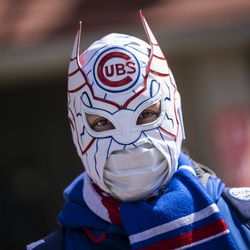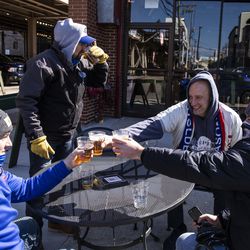Thousands of overjoyed Cubs fans returned to Wrigley Field for the first time in over a year Thursday for an unprecedented Opening Day matchup with the Pittsburgh Pirates.
Prior to the first pitch, throngs of fans chanted, cheered and posed for photographs under Wrigley’s iconic marquee at the intersection of Clark and Addison streets. Tim Gerster, of Portage Park, said the city’s move to allow a limited number of fans back to ballparks marks a shift “back to normalcy.”
“A year’s too long to be away from the Cubs,” said Gerster, who has for a decade brought his teenage son to every home opener.
As fans lined up outside, it was clear that changes had been made to the ballpark’s operations as a response to the coronavirus pandemic. Almost all fans donned protective masks and the attendees who were able to score tickets were ushered separately through socially distanced lines — a far cry from the mob scenes that were previously commonplace at the stadium’s entry points.
Kelli Serviss, a home health care worker from the Northwest Side, said she was “concerned” about coronavirus cases rising again as she posed for selfies outside the stadium with her daughter, niece and another health care worker. This week, city officials warned that baseball stadiums could again be shut down to fans if cases keep climbing.
“This does not feel like a normal Opening Day, not at all,” said Serviss, who has attended every home opener for roughly two decades. “It’s very empty. It’s very different.”
Still, Serviss said she deserves a reprieve after working through the pandemic and being vaccinated.
“Walking through the gates, I want to see that first pitch. Give me that first pitch,” she said, adding she also couldn’t wait to hear the stadium’s organ.
“I’m getting chills,” her friend, Allison Hoehn, chimed in.
By the top of the fifth inning, fans were streaming out of Wrigley’s main entrance. While some complained it was too cold in certain parts of the stadium, others said they were frustrated the mobile app needed to order beers and hot dogs wasn’t working.
Damian Ehrlicher and his friends ducked out of the game early to grab drinks at Murphy’s Bleachers, 3665 N. Sheffield Ave. But Ehrlicher, an Edison Park resident who’s attended around 35 straight openers, took the hiccup in stride.
“At the end of the day, aren’t you happy just to be out and be somewhat getting back to normal? … [Is it] aggravating? Yeah, but they weren’t prepared for it,” said Ehrlicher, the CEO of ProtectedIT, a managed security services provider based in Chicago.
“It is what it is,” he said. “They’ve had worse Opening Days.”
The beer-fueled bacchanal that typically extends to neighborhood taverns on game days appeared to be hampered by coronavirus-related restrictions. Though bars were able to seat limited numbers of patrons inside and on their patios, the atmosphere was docile compared to previous openers.
:no_upscale()/cdn.vox-cdn.com/uploads/chorus_asset/file/22414669/CUBSCROWD_040221_20.jpg)
Ushers said 10,000 tickets were sold for Thursday’s game, which was more than initially announced but still less than a quarter of the stadium’s capacity.
“We got scared because the seating was so limited [and] we paid way too much. But we’re here. All that matters is that we’re here,” said Richie Garcia, a Bridgeport resident who said he and his friends have a “tradition” of attending Opening Day that stretches back two decades.
Garcia said he typically attends between 50 and 60 Cubs home games each year and being shut out of Wrigley last year was “really hard” on him.
“I went through a depression, withdrawals and all that other stuff,” he said. “But you know what? We’re back. It’s OK now. It’s a better day. I made it.”
:no_upscale()/cdn.vox-cdn.com/uploads/chorus_asset/file/22414257/CUBSCROWD_040221_19.jpg)
Asked about the Cubs’ prospects this year, Garcia said jokingly: “We’re going to go 162-0.”
One of the first big cheers went up for old friend Jake Arrieta, back again in a Cubs uniform, as players lined the third-base line for the kind of ceremonious introductions that happen only on special occasions like Opening Day.
It got even louder when right fielder Jason Heyward — carrying a Chicago flag — led the Cubs’ starting nine out of the dugout for the first inning.
He doffed his cap first to the fans beyond the right-field foul line, then to those in the bleachers. And then there was baseball.
Seated in tiny clusters of up to four, distanced from their neighbors, fans huddled against the cold and got, well, pretty quiet, the kind of thing that happens when voices are muffled by scarves wrapped over masks and clapping hands are muted by mitten on mitten.
Contributing: Steve Greenberg




















